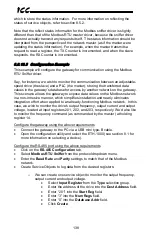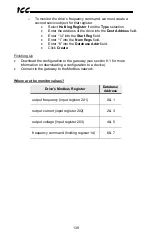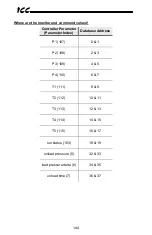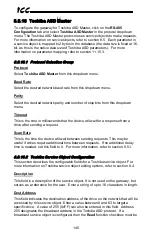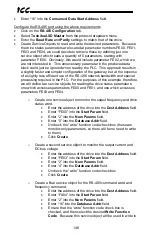
150
ICC
9.
Interacting With the Filesystem
The gateway’s on-board filesystem is used to store files for use by the application
firmware. Currently, the application firmware’s main use of the filesystem is to
store XML-encoded configuration files that dictate the characteristics of the
various protocols. Each protocol that requires configuration will have its own
XML file stored on the filesystem. For easy identification, the filename will begin
with the corresponding protocol which it configures. For example, a BACnet
configuration file’s filename will begin with “bacnet”, and an EtherNet/IP file will
begin with “eip”.
Whenever the configuration for a specific protocol is completed, it is suggested
that a backup copy of the configuration file be downloaded from the unit to a PC.
One reason for this is in case it becomes necessary to restore a previous
configuration at a later time. Another reason is that it may be desirable to load
multiple units with the same configuration, as a downloaded configuration file can
be uploaded again to any compatible unit, allowing the user to easily clone
multiple units with the same configuration. While the majority of the configuration
files that are available via FTP are recreated whenever a configuration is
downloaded via USB from the configuration utility, some of the files are available
solely over Ethernet. For example, the dashboard and alarm configuration can
only be configured via the embedded web server, and therefore these specific
configuration files are only available via FTP.
Each time the gateway boots up, it will interrogate the filesystem for the
configuration files required by the protocols currently operating in the unit. If it
does not find a required file, it will create one and initialize it with factory-default
values. Therefore, if it is ever desired to reset a protocol’s configuration to
factory-default values, this can be easily accomplished by simply deleting the
appropriate configuration file from the filesystem and rebooting the unit.
Note that the application firmware uses specific filenames for the configuration
files. This means that if a file with a different filename is loaded onto the unit, it
will be stored correctly, but will not be used by the application firmware. Similarly,
if an existing configuration file’s filename is changed, then the unit will again
create a default configuration file at next boot-up, which will be stored in the
filesystem alongside the file with the changed name.
Configuration files are only read by the protocol drivers at unit boot-up.
Therefore, if a new configuration file is loaded onto a unit’s filesystem, that unit
must be rebooted for the configuration file’s settings to take effect. Rebooting a
unit can be performed by:
•
power-cycling the gateway,
•
selecting “Reset Device” from the configuration utility, or
•
selecting the “Reboot Device” button in the Finder tab of the configuration
utility
Interacting with the filesystem is performed by use of the File Transfer Protocol
(FTP). Using FTP allows the user to interact with the files on the gateway’s
Содержание ETH-1000
Страница 44: ...43 ICC 8 7 4 BBMD Currently the BBMD is only configurable via the embedded web page Refer to section 10 11...
Страница 60: ...59 ICC Figure 10 MELSEC Client Concept...
Страница 158: ...157 ICC Figure 22 Core FTP in Connected State...
Страница 208: ...207 ICC SMin SMax Min Max multiplier Equation 1 SMin offset Equation 2...
Страница 278: ...277 ICC Figure 114 BACnet Modbus Binary Objects Discretes Big Endian...



